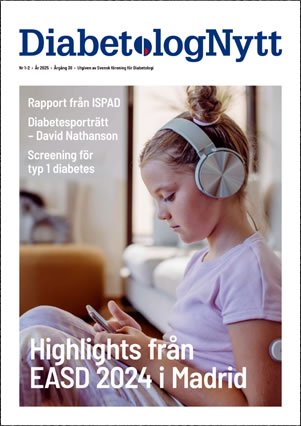Vol.:(0123456789)Diabetologia (2025) 68:41–51 https://doi.org/10.1007/s00125-024-06289-z
Intermittently scanned continuous glucose monitoring compared with blood glucose monitoring is associated with lower HbA1cand a reduced risk of hospitalisation for diabetes‑related complications in adults with type 2 diabetes on insulin therapies
David Nathanson · Katarina Eeg‑Olofsson · Tim Spelman · Erik Bülow · Mattias Kyhlstedt · Fleur Levrat‑Guillen · Jan Bolinder
Abstract
Aims/hypothesis
We assessed the impact of initiating intermittently scanned continuous glucose monitoring (isCGM) com-pared with capillary blood glucose monitoring (BGM) on HbA1c levels and hospitalisations for diabetes-related complications in adults with insulin-treated type 2 diabetes in Sweden.
Methods
This retrospective comparative cohort study included adults with type 2 diabetes who had a National Diabetes Register initiation date for isCGM after 1 June 2017. Prescribed Drug Register records identified subgroups treated with multiple daily insulin injections (T2D-MDI) or basal insulin (T2D-B), with or without other glucose-lowering drugs. The National Patient Register provided data on hospitalisation rates.
Results
We identified 2876 adults in the T2D-MDI group and 2292 in the T2D-B group with an isCGM index date after 1 June 2017, matched with 33,584 and 43,424 BGM control participants, respectively. The baseline-adjusted difference in the change in mean HbA1c for isCGM users vs BGM control participants in the T2D-MDI cohort was −3.7 mmol/mol (−0.34%) at 6 months, and this was maintained at 24 months. The baseline-adjusted difference in the change in HbA1c for isCGM users vs BGM control participants in the T2D-B cohort was −3.5 mmol/mol (−0.32%) at 6 months, and this was also maintained at 24 months. Compared with BGM control participants, isCGM users in the T2D-MDI cohort had a significantly lower RR of admission for severe hypoglycaemia (0.51; 95% CI 0.27, 0.95), stroke (0.54; 95% CI 0.39, 0.73), acute non-fatal myocardial infarction (0.75; 95% CI 0.57, 0.99) or hospitalisation for any reason (0.84; 95% CI 0.77, 0.90). isCGM users in the T2D-B cohort had a lower RR of admission for heart failure (0.63; 95% CI 0.46, 0.87) or hospitalisation for any reason (0.76; 95% CI 0.69, 0.84).
From the article
Introduction
The UK Prospective Diabetes Study (UKPDS) study has shown that intensive glucose management, starting at the time of diagnosis of type 2 diabetes, is associated with sustained reductions in the risk of myocardial infarction and death from any cause, in addition to reductions in the risk of microvascular disease [1–3]. RCTs and prospec-tive real-world studies have shown that use of continuous glucose monitoring (CGM) or intermittently scanned con-tinuous glucose monitoring (isCGM) in people with type 2 diabetes on intensive insulin therapy through multiple daily injections is associated with lower HbA1c [4–6] and reductions in hypoglycaemia [7, 8]. Likewise, RCTs and retrospective studies have also demonstrated that using these sensor-based glucose monitoring systems is associ-ated with improvements in HbA1c for people with inade-quately managed type 2 diabetes treated with basal insulin only [9–11] or on non-insulin therapies [12–14].
Together with reductions in HbA1c and hypoglycaemia, CGM-derived metrics are now emerging as surrogate end-points for microvascular and macrovascular complications of type 1 and type 2 diabetes [15]. For people with type 2 diabetes, improved CGM metrics for time in range are associated with a decreased risk of retinopathy [16, 17] and renal disease [18]. In terms of macrovascular outcomes, lower time in range and glycaemic variability are associ-ated with risk markers for CVD in type 2 diabetes [19–22], and lower time in range in people with type 2 diabetes is associated with an increased risk of all-cause and CVD mortality [23], as well as peripheral artery disease [24]. Although these observations may suggest that microvas-cular and macrovascular events leading to hospitalisation should decrease for people with type 2 diabetes using CGM, no studies, to our knowledge, have investigated in greater detail the rate of hospital admissions for diabetes-related complications in people with type 2 diabetes following ini-tiation of CGM as part of their glycaemic management.In Sweden, approximately 5.0% of the entire population are recorded in the National Diabetes Register (NDR) as having type 2 diabetes, with a registry coverage of 90% [25]. The NDR has been an integral part of diabetes care in Swe-den since 1996, and registration of people with diabetes in Sweden is encouraged at least once per year. The goal of the NDR is to monitor and improve diabetes care, as well as to reduce diabetes-related morbidity and mortality. As part of this mission, the NDR facilitates comparisons between a range of treatment modalities and clinical outcome meas-ures.
From June 2016 onwards, the NDR has documented use of CGM devices among adults with diabetes, including isCGM.In the current study, using the unique ten-digit personal identity number assigned to permanent residents in Swe-den [26], we linked data from the NDR on adults with type 2 diabetes who were recorded as isCGM users with data on those using conventional capillary blood glucose monitoring (BGM). The information from the NDR was then linked with data from the Swedish Prescribed Drug Register (SPDR) [27], which contains individualised data on prescribed drugs, to identify subgroups of people with type 2 diabetes treated with multiple daily insulin injections (T2D-MDI) or on basal insulin (T2D-B), with or without non-insulin glucose-lowering drugs. These data were then cross-linked with the Swedish National Patient Register (NPR) of hospital admissions [28].The aims of this study were to assess the impact of initi-ating isCGM compared with BGM on longitudinal changes in HbA1c from baseline for adults in Sweden with type 2 diabetes on intensive or non-intensive insulin therapy, and to investigate the occurrence of severe hypoglycaemia and the rates of hospital admission for known microvascular and macrovascular complications of diabetes and overall hospi-talisation for any reason.
Conclusion
This real-world retrospective cohort study of adults with type 2 diabetes in Sweden, using analysis of data from the NDR linked with comprehensive prescribing information from the SPDR, has shown that adults with type 2 diabetes on intensive insulin therapy with multiple daily injections and adults with type 2 diabetes treated with basal insulin only achieve significant and comparable reductions in HbA1c 6 months after being prescribed isCGM, and these reductions persist for at least 24 months. Furthermore, both in adults with type 2 diabetes treated with multiple daily injections and adults with type 2 diabetes treated with basal insulin, the reductions in HbA1c are positively correlated with the HbA1c at baseline.
In addition, we have been able to demonstrate a signifi-cantly lower risk of hospitalisation for severe hypoglycaemia or for major cardiovascular events, or hospitalisation for any reason, for adults with type 2 diabetes following initiation of use of the isCGM system compared with control participants who are using BGM. These outcomes have direct conse-quences for optimising health-related outcomes for people with type 2 diabetes, and have implications for the long-term cost-effectiveness of providing access to isCGM for people with type 2 diabetes on insulin therapies
https://diabetologia-journal.org/editors-choice/intermittently-scanned-continuous-glucose-monitoring-compared-with-blood-glucose-monitoring-is-associated-with-lower-hba1c-and-a-reduced-risk-of-hospitalisation-for-diabetes-related-complications-in-a/
Nyhetsinfo
www red DiabetologNytt





